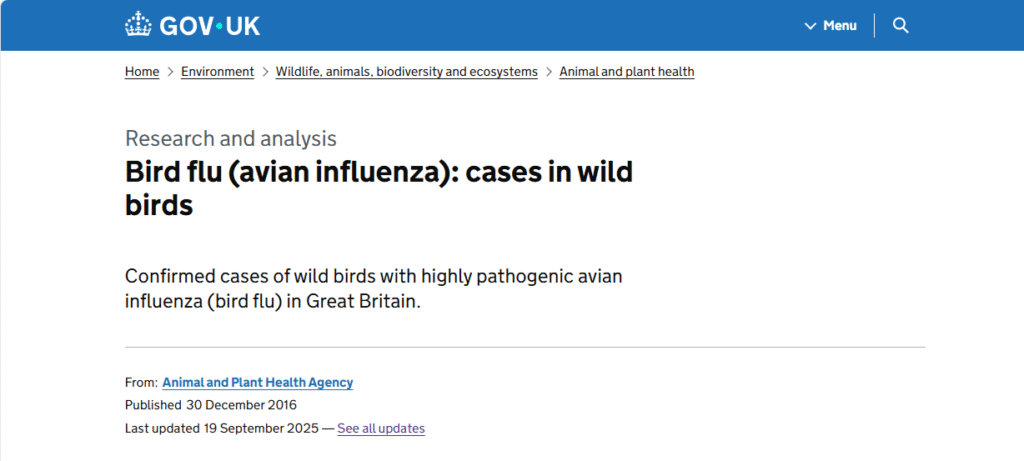
The Department for Environment, Food and Rural Affairs has published positive cases of bird flu for each week since the last two weeks of December 2016. These figures used to be updated weekly but large gaps are now appearing between updates – click here.
Positive cases are dead birds sent in to the authorities in each of the four UK nations. These will not be an unbiased sample of species because at various times the relevant authorities have made it clear that they are particularly interested in certain groups of species (eg raptors, waterfowl) and that may be why such species are strongly represented in the lists below. Large and conspicuous species are also overrepresented in the lists below. There are other issues with the dataset but this level of openness allows us to see which species of ‘wild bird’ have tested positive in each calendar year.
I have simply list, initially for my own interest, all the species which tested positive in the UK each year from the current year back to 2017. The earliest year a species appears in the lists is in red type. A total of 87 species have tested positively for bird flu in this almost 9-year period.
2025 (so far), 45 species: Mute Swan, Whooper Swan, Bewick’s Swan, Greylag Goose, Canada Goose, Pink-footed Goose, Barnacle Goose, Shelduck, Mallard, Eider, White-tailed Eagle, Red Kite, Buzzard, Goshawk, Sparrowhawk, Peregrine, Kestrel, Curlew, Herring Gull, Lesser Black-backed Gull, Black-headed Gull, Mediterranean Gull, Yellow-legged Gull, Great Black-backed Gull, Common Gull, Kittiwake, Little Gull, Sandwich Tern, Arctic Tern, Common Tern, Roseate Tern, Gannet, Fulmar, Manx Shearwater, Cormorant, Razorbill, Guillemot, Puffin, Barn Owl, Long-eared Owl, Tawny Owl, Grey Heron, Pheasant, Greenfinch and Starling.
2024, 21 species: Mute Swan, Whooper Swan, Greylag Goose, Canada Goose, Mallard, White-tailed Eagle, Red Kite, Buzzard, Sparrowhawk, Peregrine, Kestrel, Great Skua, Herring Gull, Black-headed Gull, Great Black-backed Gull, Common Gull, Gannet, Fulmar, Cormorant, Barn Owl, Pheasant.
2023, 46 species: Mute Swan, Whooper Swan, Greylag Goose, Canada Goose, Pink-footed Goose, Barnacle Goose, Mallard, Teal, Red Kite, Buzzard, Goshawk, Sparrowhawk, Peregrine, Kestrel, Merlin, Ringed Plover, Herring Gull, Lesser Black-backed Gull, Black-headed Gull, Mediterranean Gull, Great Black-backed Gull, Common Gull, Kittiwake, Sandwich Tern, Arctic Tern, Common Tern, Roseate Tern, Little Tern, Gannet, Fulmar, Cormorant, Shag, Razorbill, Guillemot, Puffin, Moorhen, Coot, Barn Owl, Tawny Owl, Grey Heron, Red Grouse, Pheasant, Woodpigeon, Feral Pigeon, Carrion Crow, Reed Warbler.
2022, 65 species: Great Northern Diver, Red-throated Diver, Great Crested Grebe, Mute Swan, Whooper Swan, Black Swan, Greylag Goose, Canada Goose, Pink-footed Goose, White-fronted Goose, Barnacle Goose, Red-breasted Goose, Mallard, Gadwall, Pintail, Tufted Duck, Goosander, Eider, White-tailed Eagle, Golden Eagle, Osprey, Hen Harrier, Red Kite, Buzzard, Goshawk, Sparrowhawk, Peregrine, Kestrel, Curlew, Oystercatcher, Great Skua, Long-tailed Skua, Herring Gull, Lesser Black-backed Gull, Black-headed Gull, Great Black-backed Gull, Common Gull, Kittiwake, Sandwich Tern, Arctic Tern, Common Tern, Roseate Tern, Gannet, Fulmar, Manx Shearwater, Cormorant, Razorbill, Guillemot, Puffin, Moorhen, Coot, Barn Owl, Tawny Owl, Grey Heron, Little Egret, Great Egret, Pheasant, Red-legged Partridge, Great Spotted Woodpecker, Woodpigeon, Feral Pigeon, Carrion Crow, Magpie, Blackbird, Pied Wagtail.
2021, 25 species: Great Crested Grebe, Mute Swan, Whooper Swan, Black Swan, Greylag Goose, Canada Goose, Pink-footed Goose, Barnacle Goose, Mallard, Wigeon, White-tailed Eagle, Red Kite, Buzzard, Sparrowhawk, Peregrine, Kestrel, Lapwing, Curlew, Red Knot, Great Skua, Herring Gull, Black-headed Gull, Grey Heron, Pheasant, Rook.
2020, 19 species: Little Grebe, Mute Swan, Whooper Swan, Black Swan, Greylag Goose, Canada Goose, Pink-footed Goose, Barnacle Goose, Brent Goose, Wigeon, Shelduck, Buzzard, Sparrowhawk, Peregrine, Kestrel, Herring Gull, Lesser Black-backed Gull, Grey Heron, Great Egret.
2019: None.
2018, 15 species: Great Crested Grebe, Mute Swan, Greylag Goose, Canada Goose, Mallard, Tufted Duck, Pochard, Buzzard, Goshawk, Herring Gull, Black-headed Gull, Great Black-backed Gull, Common Gull, Moorhen, Pheasant.
2017 (and last two weeks of 2016) 14 species: Mute Swan, Whooper Swan, Greylag Goose, Canada Goose, White-fronted Goose, Wigeon, Teal, Tufted Duck, Pochard, Buzzard, Peregrine, Kestrel, Black-headed Gull, Cormorant.
What can we make of this? Well, not much as the sample is biased, for sure. And not much because we don’t know how many birds were tested and were negative for bird flu. For example, only one Blackbird has tested positive for bird flu over this period – is that one out of thousands of Blackbirds tested or the only Blackbird tested? I’d love to know the proportion of birds, for each species which tested positive and the sample size.
But at a very simple level we can see that although bird flu has receded in the headlines it hasn’t gone away. 2025 has seen many species affected including some new species.
From 2016 to 2021 avian flu was mainly a winter disease (you can see that from the more detailed records on the Defra website) but in 2022 it broke through in a big way into the bird breeding season and had major impacts on many colonial seabird species. 2023 saw lots more deaths from bird flu but then things seemed to be calming down in 2024. This year has already shown that there is plenty of bird flu swishing around out there.
I wonder what the future will hold – we aren’t done with this yet, I fear.
[registration_form]
Source link




